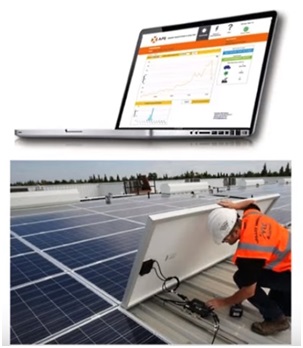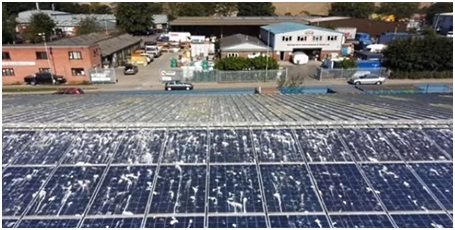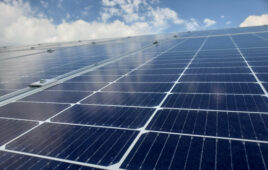In a recent webinar Chris Barrett, technical services manager at APsystems, discussed the advantages of using microinverters in commercial projects. Here’s a recap of the conversation. You can watch the full webinar here.
Microinverters have a number of benefits when used in a commercial installation, including increased safety, NEC compliance, comprehensive monitoring, higher energy harvest, and greater reliability than many string inverter options.
Safety and NEC-compliance
Inherent to their design, microinverters do not require high-voltage DC running across the roof as a string inverter system would. Instead, about 30V DC runs out of the panels into the microinverter and is then converted to AC power—right on the roof. This avoids the very high voltages (600V or higher) that would be running off the roof into a string system. The lower voltages of microinverters makes the system safer for property owners, emergency responders, and maintenance workers.

Microinverters comply with the NEC standards by design. Safety codes like NEC 690.12 for rapid shutdown, and 690.11 for arc-fault protection, require quick action to protect first responders in case of a fire — the system must be de-energized within 10 seconds of shutdown under the code. Microinverters actually achieve this much quicker. When AC is not present, the microinverters will shut down within 100 milliseconds, 100 times faster than the code requires. In the worst case, first responders on a roof with a microinverter system will encounter just 30V DC, which is not considered hazardous – and the microinverters themselves will be under the modules, further shielding them from inadvertent contact.
 System monitoring
System monitoring
While a string inverter system monitors groups of modules as a single unit, a microinverter system monitors each module individually. This allows the end user to check output and uptime of every single module through an online interface, for more precise system monitoring than afforded by string arrays. You will know the modules are on and running at all times, and exactly how they are performing. Any issue with a module can be easily identified and corrected – saving the time and money that would be spent trying to figure out where the problem is in a string inverter system.
Energy harvest
The next big thing for microinverters is increased energy harvest. Microinverters, by their design, are converting power right on the roof, panel by panel. This helps minimize the effects of shading or soiling that can inhibit performance. In a string inverter system, shading across one module would compromise the entire array. Microinverters ensure that you’re producing power at the highest level per panel at all times.
Microinverters also turn on and start producing power at a lower voltage than string inverters (about 21V rather than 200V). This means that microinverters will turn on earlier in the morning and work later into the evening, increasing energy harvest through the day.

Reliability and uptime
Reliability is important for energy harvest. Microinverters are in a unique position in regard to reliability as well. If a microinverter does fail, or has an issue, it’s only one unit out of the entire system, as opposed to a string system in which one failure will take out a whole group of modules.
Reliability of the microinverter doesn’t just relate to power production, but also reliability to communicate the production of that power. If a string inverter goes down, it stops communicating information about the system. Whereas microinverters actually create a “mesh” network; even if one unit is down, they can still talk to the others and pass performance data along back to the controller.

One last important aspect of microinverters is that most carry a 25-year warranty, as opposed to a typical 10-year warranty from string inverters. Microinverters have proven themselves in many challenging environments and will prove a good choice in commercial-scale projects too.





Tell Us What You Think!